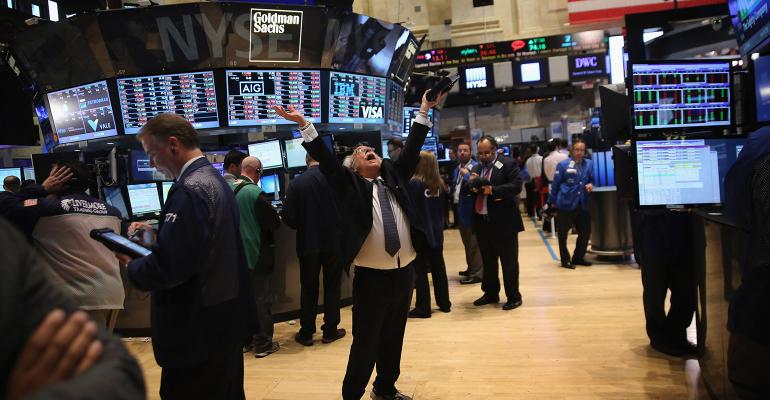(Bloomberg Opinion) -- For the past month, bond traders confronted nothing short of chaos at every turn. U.S. Treasuries, mortgage-backed securities, investment-grade and high-yield corporate bonds, leveraged loans and collateralized loan obligations, it didn’t matter. Everything was for sale, and no one was willing — or, in many cases, able — to buy.
That relentless tide is starting to turn as March draws to a close. Thanks to a series of bold steps by the Federal Reserve, namely its promise to buy as many Treasuries and agency mortgage-backed securities as necessary, its unprecedented venture into the investment-grade credit market and its deeper expansion into municipal bonds, traditionally safe debt is showing signs of returning to more normal yields and spreads. Blue-chip companies feel comfortable borrowing again.
Don’t necessarily take the latest dire fund flow numbers at face value. Yes, investment-grade bond funds experienced a record $38 billion outflow in the week through March 25, as did munis with $13.7 billion of withdrawals. But individual investors are drawn to winning asset classes. And these securities have staged comebacks that are unprecedented in recent memory.
The same optimism hasn’t reached the riskier parts of the debt markets. The amount of bonds and loans trading at distressed levels in the U.S. quadrupled in less than a week to almost $1 trillion, nearing the 2008 peak, Bloomberg News’s Katherine Doherty reported. Credit-rating companies are downgrading companies at the fastest pace in more than a decade, ushering in several large fallen angels like Ford Motor Co. and Occidental Petroleum Corp. Mortgage real estate investment trusts have been pummeled by margin calls from banks anxious that tenants won’t cover rent. As it stands, the Fed’s programs won’t backstop these parts of the market — probably for good reason.
Simply put, the bond market has bifurcated into winners and losers after this month’s mayhem. Here’s what the divide looks like:
Winner: U.S. Treasuries
It took a record amount of buying from the Fed, and a pledge to purchase much more, but the world’s biggest bond market showed clear signs of tranquility this week. On March 19, the spread between liquid on-the-run 10-year debt and older off-the-run securities was four basis points, or eight times as high as a month earlier. On Monday, after the Fed’s scrapped its limits on quantitative easing, the spread dropped to 1.6 basis points. By Thursday, it fell to 0.4 basis points.
The MOVE index of implied volatility for the U.S. government bond market also indicates more orderly Treasuries trading. It hit the lowest level since Feb. 26 on Wednesday, after the sharpest two-day percentage decline since data begin in 1988. Benchmark yields across the curve are settling into sensible ranges — a major win for the Fed.
Winner: Investment-grade corporate bonds
Yes, the yield spread on the Bloomberg Barclays index of high-grade corporate bonds reached 373 basis points on Monday, the widest since 2009. But it’s looking increasingly like that’ll be the worst of it. That gap narrowed 20 basis points on Tuesday and then 29 basis points on Wednesday. A tightening of that magnitude has never happened since daily data began in 2000.
In what’s arguably an even more encouraging sign of market health, more investment-grade companies are choosing to issue new debt. McDonald’s Corp., Nike Inc., 3M Co. and Deere & Co. were among those that priced deals amid Wednesday’s rally, while Nvidia Corp., Home Depot Inc. and Target Corp. were marketing bond offerings on Thursday. Because Treasury yields are near record lows, these companies are still borrowing at rates similar to those a year ago.
Loser: High-yield corporate bonds
At first glance, junk bonds appear to be on a similar trajectory as their high-grade counterparts. Spreads on the Bloomberg Barclays high-yield index peaked at 1,100 basis points on Monday before tightening by 75 basis points over the next two days. On a relative basis, that’s still not nearly the same rebound.
Unlike the investment-grade market, high-yield issuance is nonexistent while so much uncertainty remains about the coronavirus outbreak and length and impact of the U.S. economic halt. No deals are scheduled. At best, there’s speculation about potential offerings in the coming months.
To make matters worse, the longstanding fear of a wave of fallen angels overwhelming the junk-bond market is finally starting to materialize. In the biggest example, Ford’s $35.8 billion of debt will be removed from the Bloomberg Barclays investment-grade index at the end of the month and move into high yield. Meanwhile, those companies already rated junk are looking more at risk of folding: S&P Global Ratings said this month that the default rate on U.S. nonfinancial corporate debt may rise above 10%.
Loser: Leveraged loans, riskier CLOs
It’s mostly the same story, if not worse, in leveraged loans. The distressed trading level is defined as corporate bonds that yield at least 10 percentage points above Treasuries and loans that trade for less than 80 cents on the dollar. The S&P/LSTA Leveraged Loan Price Index was hovering just above 76 cents at the beginning of the week. It increased on Wednesday for the first time since March 10 but remains firmly below that distressed threshold.
No loans launched or priced this week. There aren’t even any bank meetings scheduled. This market is almost entirely frozen, though some buyers have been looking to buy scarce double-B credits and the largest, most liquid obligations.
Leveraged loans’ credit ratings are an important flashpoint for certain parts of collateralized loan obligations. Generally, CLOs have a 7.5% limit for triple-C rated loans. The way they’re structured, though, it would take an enormous amount of downgrades to even begin to concern top-rated tranches. Indeed, on Wednesday, Citigroup Inc. published a report titled “CLO AAA Screams Cheap.” In the same breath, though, the strategists noted “the spread pickup of CLO BB to BBB breached post-crisis highs last week, suggesting serious credit risk concerns.” In other words, the lower-rated tranches are definitely dicey, but the safest portions are being unduly punished along with them.
Winner: Agency mortgage-backed securities
This one is a bit of a no-brainer. The Fed’s open-ended QE includes mortgage securities guaranteed by Ginnie Mae, Fannie Mae and Freddie Mac. These have bounced back in a big way, recouping all their losses from the last two weeks.
The central bank bought $39 billion on Wednesday, $36 billion on Tuesday and $30 billion on Monday. For some context, before this month, the highest total for an entire week was $33 billion in March 2009.
Loser: Private commercial MBS, mortgage REITs
As my Bloomberg Opinion colleague Matt Levine put it yesterday, “nobody wants a margin call right now.”
Of course, that’s exactly what’s happening to mortgage real-estate investment trusts. As I wrote earlier this week, the REITs have plunged in price because banks are worried that closed tenants will miss rent, which will cause landlords to miss mortgage payments, which will wipe out the cash flow to commercial mortgage-backed securities. A Bloomberg Barclays index of “U.S. CMBS 2.0,” which is the market of conduit and fusion CMBS deals issued since January 2010, is down almost 11% this month, easily the biggest loss ever.
The Fed isn’t heavy-handed in this nonagency part of the mortgage market, though some investors are pleading for the central bank to do more. Until then, each day the U.S. economy remains halted creates further pain for these securities.
Winner: Municipal bonds
To end on a positive note: Look at munis go!
In what I’d describe as nothing short of breathtaking, the yield on 10-year, triple-A munis tumbled by 138 basis points in three days, with Wednesday representing the biggest one-day advance since 1993. If any investor was looking for evidence of a “V-shaped” recovery, look no further than the iShares National Muni Bond ETF (ticker: MUB). In a matter of days, it went from its lowest price since 2013 to rocketing back to roughly the same level it started at in 2020.
This doesn’t usually happen to the $3.9 trillion municipal market. Traditionally, steep losses and huge outflows begin a vicious cycle of more withdrawals and further forced selling. All those pieces were in place as of last week. The Fed did signal a bit of support to the market since then, and the $2 trillion fiscal relief bill in Washington does pledge monetary support to local governments, but that doesn’t feel like the entire story. More likely, opportunistic investors saw muni ETFs trade at wider discounts to their net asset values than any other fund, and individual bond pickers noticed 10-year tax-exempt yields three times as high as taxable Treasuries, and determined it was too cheap to pass up.
In that sense, munis were a microcosm of the $100 trillion global bond market: Things got weird in a hurry. Central banks swiftly provided liquidity and gave investors a chance to breathe again. Now it’s time to sort through the wreckage.
To contact the author of this story:
Brian Chappatta at [email protected]
To contact the editor responsible for this story:
Daniel Niemi at [email protected]






